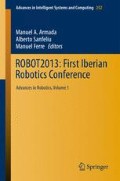Abstract
Endowing current surgical robotic systems with haptic feedback to perform minimally invasive surgery (MIS), such as laparoscopy, is still a challenge. Haptic is a feature lost in surgical teleoperated systems limiting surgeons capabilities and ability. The availability of haptics would provide important advantages to the surgeon: Improved tissue manipulation, reducing the breaking of sutures and increase the feeling of telepresence, among others. To design and develop a haptic system, the measurement of forces can be implemented based on two approaches: Direct and indirect force sensing. MIS performed with surgical robots, imposes many technical constraints to measure forces, such as: Miniaturization, need of sterilization or materials compatibility, making it necessary to rely on indirect force sensing. Based on mathematical models of the components involved in an intervention and indirect force sensing techniques, a global perspective on how to address the problem of measurement of tool-tissue interaction forces is presented.
Access this chapter
Tax calculation will be finalised at checkout
Purchases are for personal use only
Preview
Unable to display preview. Download preview PDF.
References
Okamura, A.M.: Haptic feedback in robot-assisted minimally invasive surgery. Current Opinion in Urology 19(1), 102 (2009)
van den Dobbelsteen, J.J., Lee, R.A., van Noorden, M.: Indirect measurement of pinch and pull forces at the shaft of laparoscopic graspers. Medical & Biological Engineering & Computing 50(3), 215–221 (2012)
Sciavicco, L.: Robotics: modelling, planning and control. Springer (2009)
Picod, G., Jambon, A.C., Vinatier, D., Dubois, P.: What can the operator actually feel when performing a laparoscopy? Surgical Endoscopy and Other Interventional Techniques 19(1), 95–100 (2005)
Van den Dobbelsteen, J.J., Schooleman, A., Dankelman, J.: Friction dynamics of trocars. Surgical Endoscopy 21(8), 1338–1343 (2007)
Yang, T., Xiong, L., Zhang, J., Yang, L., Huang, W., Zhou, J., Liu, J., et al.: Modeling cutting force of laparoscopic scissors. In: 2010 3rd International Conference on Biomedical Engineering and Informatics (BMEI), pp. 1764–1768. IEEE (2010)
Meier, U., Lpez, O., Monserrat, C., Juan, M.C., Alcaniz, M.: Real-time deformable models for surgery simulation: a survey. Computer Methods and Programs in Biomedicine 77(3), 183–197 (2005)
Rosen, J., Brown, J.D., Chang, L., Sinanan, M.N., Hannaford, B.: Generalized approach for modeling minimally invasive surgery as a stochastic process using a discrete Markov model. IEEE Transactions on Biomedical Engineering 53(3), 399–413 (2006)
Kim, J., Janabi-Sharifi, F., Kim, J.: A haptic interaction method using visual information and physically based modeling. IEEE/ASME Transactions on Mechatronics 15(4), 636–645 (2010)
Greminger, M.A., Nelson, B.J.: Modeling elastic objects with neural networks for vision-based force measurement. In: Proceedings of the 2003 IEEE/RSJ International Conference on Intelligent Robots and Systems, IROS 2003, vol. 2, pp. 1278–1283. IEEE (2003)
Frank, B., Schmedding, R., Stachniss, C., Teschner, M., Burgard, W.: Learning Deformable Object Models for Mobile Robot Navigation using Depth Cameras and a Manipulation Robot. In: Proc. of the IEEE Intl. Conf. on Robotics & Automation, ICRA (2010)
Bickel, B., Bcher, M., Otaduy, M.A., Matusik, W., Pfister, H., Gross, M.: Capture and modeling of non-linear heterogeneous soft tissue. ACM Transactions on Graphics (TOG) 28(3), 89 (2009)
Fumagalli, M., Gijsberts, A., Ivaldi, S., Jamone, L., Metta, G., Natale, L., Nori, F., Sandini, G.: Learning to exploit proximal force sensing: a comparison approach. In: Sigaud, O., Peters, J. (eds.) From Motor Learning to Interaction Learning in Robots. SCI, vol. 264, pp. 149–167. Springer, Heidelberg (2010)
Jamali, N., Sammut, C.: Slip prediction using Hidden Markov models: Multidimensional sensor data to symbolic temporal pattern learning. In: 2012 IEEE International Conference on Robotics and Automation (ICRA), pp. 215–222. IEEE (2012)
Sinapov, J., Sukhoy, V., Sahai, R., Stoytchev, A.: Vibrotactile recognition and categorization of surfaces by a humanoid robot. IEEE Transactions on Robotics 27(3), 488–497 (2011)
Kuchenbecker, K.J., Gewirtz, J., McMahan, W., Standish, D., Martin, P., Bohren, J., Mendoza, P.J., Lee, D.I.: VerroTouch: high-frequency acceleration feedback for telerobotic surgery. In: Kappers, A.M.L., van Erp, J.B.F., Bergmann Tiest, W.M., van der Helm, F.C.T. (eds.) EuroHaptics 2010, Part I. LNCS, vol. 6191, pp. 189–196. Springer, Heidelberg (2010)
McMahan, W., Gewirtz, J., Standish, D., Martin, P., Kunkel, J.A., Lilavois, M., Wedmid, A., Lee, D.I., Kuchenbecker, K.J.: Tool contact acceleration feedback for telerobotic surgery. IEEE Transactions on Haptics 4(3), 210–220 (2011)
Reiley, C.E., Akinbiyi, T., Burschka, D., Chang, D.C., Okamura, A.M., Yuh, D.D.: Effects of visual force feedback on robot-assisted surgical task performance. The Journal of Thoracic and Cardiovascular Surgery 135(1), 196–202 (2008)
Talasaz, A., Trejos, A.L., Patel, R.V.: Effect of force feedback on performance of robotics-assisted suturing. In: 2012 4th IEEE RAS & EMBS International Conference on Biomedical Robotics and Biomechatronics (BioRob), pp. 823–828. IEEE (2012)
Author information
Authors and Affiliations
Corresponding author
Editor information
Editors and Affiliations
Rights and permissions
Copyright information
© 2014 Springer International Publishing Switzerland
About this chapter
Cite this chapter
Marbán, A., Casals, A., Fernández, J., Amat, J. (2014). Haptic Feedback in Surgical Robotics: Still a Challenge. In: Armada, M., Sanfeliu, A., Ferre, M. (eds) ROBOT2013: First Iberian Robotics Conference. Advances in Intelligent Systems and Computing, vol 252. Springer, Cham. https://doi.org/10.1007/978-3-319-03413-3_18
Download citation
DOI: https://doi.org/10.1007/978-3-319-03413-3_18
Publisher Name: Springer, Cham
Print ISBN: 978-3-319-03412-6
Online ISBN: 978-3-319-03413-3
eBook Packages: EngineeringEngineering (R0)

